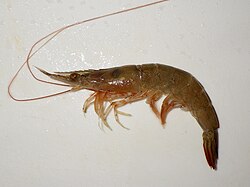| Metapenaeus ensis | |
|---|---|
 | |
| Scientific classification | |
| Kingdom: | Animalia |
| Phylum: | Arthropoda |
| Class: | Malacostraca |
| Order: | Decapoda |
| Suborder: | Dendrobranchiata |
| Family: | Penaeidae |
| Genus: | Metapenaeus |
| Species: | M. ensis |
| Binomial name | |
| Metapenaeus ensis (De Haan, 1844) | |
| Synonyms [1] | |
Metapenaeus mastersiiHall, 1962 | |
Metapenaeus ensis (sometimes called the greasyback shrimp or sand shrimp ) is a species of prawn. [2] [3]
